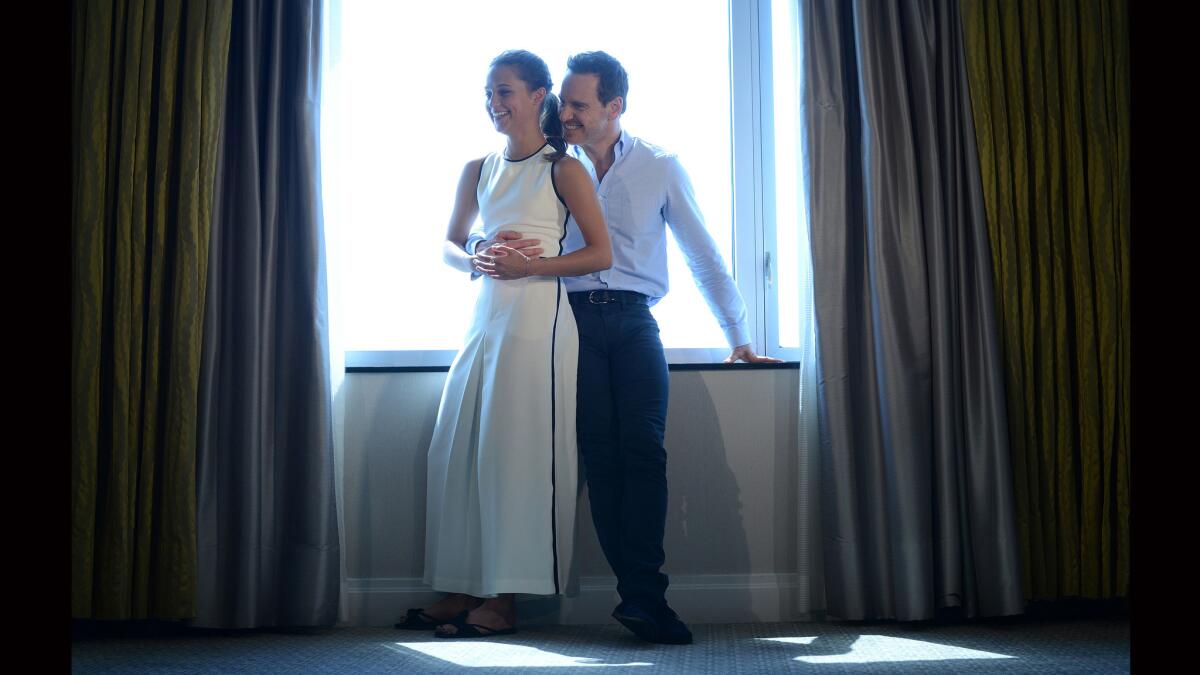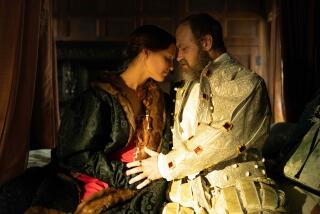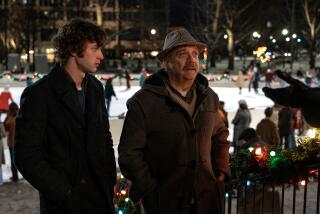‘Light Between Oceans’ stars Fassbender and Vikander seek a private romance in the age of instant exposure

Reporting from New York — Michael Fassbender tensed up for the briefest instant when the topic of his relationship with Alicia Vikander, both his co-star and his girlfriend, arose.
Then he relaxed and offered a Zen thought. “People will make the presumptions they want to make. If you start to defend anything, it becomes, ‘Methinks the lady doth protest too much,’ ” the actor said, when asked if he thought moviegoers would draw real-life inferences from his work.
“I mean, have you seen ‘Shame?’ ” he quipped, referring to his 2011 portrayal of a sex addict. Vikander, sitting next to him, let loose a sharp laugh.
The pair were side by side at a downtown hotel here recently, polite and formal and trying not to seem like they’re a couple — while trying not to seem like they were trying not to seem like a couple.
Over the course of a conversation, about their new movie “The Light Between Oceans,” they could be professional, even distant. But they also jumped in often to finish each other’s sentences in a manner that reinforced their couplehood — an embodiment of the contradiction that occurs when the modern imperative to stay on message collides with the even more modern reality of everyone knowing everything about everybody.
Since the days of early Hollywood, actors have been falling for each other on set. And for pretty much just as long, we’ve been obsessed with them.
From Richard Burton and Elizabeth Taylor on “Cleopatra” in the early 1960s, engaging in a moltenly dysfunctional affair, to Brad Pitt and Angelina Jolie on “Mr. & Mrs. Smith” in the mid-2000s, also initiating a romance outside one partner’s committed relationship, mid-production hookups have been a regular source of film-fan fascination.
The reason has often had as much to do with us as them: These relationships offer the universal touchstone of the office romance, only more heightened and surreal.
But as it has in so many other areas, the age of social media and rampant exposure has changed the equation. When Jolie and Pitt were first rumored to be together on the “Mr. & Mrs. Smith” set, the idea of an affair broadcast widely using modern media tools was still new. It compelled us for months, right up through when the film landed in theaters.
Even reporting in that pre-TMZ era was tricky — for a time there was just one stealth photograph of the couple holding hands on set, kicking off a feeding frenzy to the set by glossy magazines and TV shows.
Because every iPhone-bearing fan in a corner Starbucks has now become a reporter, that kind of surprise — never mind a slow-burn reveal — is almost nonexistent these days. Knowledge about star pairings comes at us much faster, the secrets far fewer.
Into this climate arrive Fassbender, Vikander and the love story of “Light,” unloosing a rippling cinematic view on the real lives of two very private people (or at least the appearance of their real lives.)
A Derek Cianfrance adaptation of M.L. Stedman’s bestseller, out Friday after a Venice premiere, “Light” charts a coupling in post-World War I Australia, where young Tom and Isabel (Fassbender and Vikander) meet, wed and take romantic refuge on a remote island. She is sheltered; he, a returning veteran, is scarred. The movie spends many scenes luxuriating in their idyll.
Their intimacy is fractured when Isabel suffers two miscarriages. And it’s re-cemented, sort of, when the couple decides to raise a baby that has mysteriously washed ashore without reporting what they’ve done.
The movie offers moral quandaries galore — for Isabel, too shattered to do the right thing; for Tom, too loyal to his wife to dissuade her. As their lie threatens to get out, “Light” presents a kind of cautionary tale.
See the most-read stories in Entertainment this hour »
To current moviegoers, though, it furnishes something else: a chance to see art imitating life for the ethereally beautiful and previously single personalities. Fassbender and Vikander met on the Australia-New Zealand set of the film, Cianfrance’s famously naturalist and dogged style — “to find the collision between fiction and nonfiction,” as he puts it — bringing them ever closer together. The American indie director had cast and crew live on an Oceanic island in a self-described summer camp. Romantic scenes of just a few minutes could run much of the day; many were shot at extremely close range.
“Alicia would say that watching Derek’s films, you feel like you shouldn’t be in the room with these people,” Fassbender said.
“You want to get out,” Vikander nodded, adding, “This is a film about good people who don’t always make the right decisions. And we knew that to achieve that we had to make you really feel them.”
“And to be that truthful,” Fassbender added, “you have to be in these honest intimate places.”
The in-production relationship can of course create competing interests — between the couple and personal publicists, who want to protect privacy, and the studio, whose primary goal is to serve the movie. While it’s never explicitly used in marketing, fan interest in real-life relationships in the 21st century can sell tickets, as those behind several of Kristen Stewart-Robert Pattinson’s “Twilight Saga” films know well. It can also cast a pall when those relationships don’t work out, as those behind later “Twilight Saga” films also know well.
For both the Irish German Fassbender, 39, and the Swedish Vikander, 27, “Light” marks a departure of sorts.
He’s had a notably versatile few years, playing characters as diverse as Carl Jung, Steve Jobs and Magneto, but has largely stayed away from love stories; the most recent was “Jane Eyre” nearly six years ago. She has been equally range-y, going in the last 18 months from “Ex Machina” to “Jason Bourne,” though she has similarly stayed away from romance, save for the unconventional love of “The Danish Girl,” which netted her an Oscar earlier this year.
Fassbender had already been cast when the young Swede, not yet well-known, sought out the part of Isabel. “I mentioned to my agent that Derek was one of the young directors I admired and Michael was one of the best actors over the last few years.”
“I didn’t really know any of her work until we got out to Wellington,” Fassbender said. “And on the first day she comes in as this very powerful force, and I saw just how far she was willing to fall on her face. I thought …, I better stay on my toes.”
Cianfrance describes their skills as very different. “Michael is the champ who could knock you out in the first round while Alicia can do 30 takes and gets better with each take, like Gena Rowlands or Vivien Leigh. It’s the heavyweight and the thoroughbred, Muhammad Ali vs. Seabiscuit.”
Cianfrance said he wasn’t paying attention to their personal lives and was just focused on them getting the job done. Still, a director’s film tends to benefit when acting and real life converge, a kind of Method acting to the extreme. Cianfrance also may be sought for a “Fiddler on the Roof” reboot next: So potent are his matchmaking skills that his previous film, the multi-generational drama “The Place Beyond the Pines,” was also responsible for a coupling, between Ryan Gosling and Eva Mendes.
“I guess bring it on,” said the director, an entertainingly candid persona, in his trademark gravelly voice, speaking of his Yente-like reputation. “I’ll be the best man.”
On-set romance lends a larger than life quality, the movie and the headlines in a kind of ongoing dialogue. Such a dynamic was at work for Gosling and Rachel McAdams on “The Notebook,” the line so blurred that Gosling used to crack that people thought he could build a house because his character did so in the film. An epic quality also attached itself to the “Brokeback Mountain”-enabled coupling of Michelle Williams and Heath Ledger — a romance that took an elegiac turn when Ledger died in 2008 shortly after their breakup.
It also can go the other way, toward blood sport, as the endless Ben Affleck and Jennifer Lopez saga of the “Gigli”-ified early 2000s demonstrated.
The paradox of the celebrity relationship at the current social-media moment is that revealing less can make people interested more.
That’s the odd position in which Fassbender and Vikander, a fiercely private couple, find themselves.
“I have a lot of friends who do it. Just not me,” Vikander said of those social media platforms.
“I’m just lazy,” Fassbender said.
The couple is, in a sense, trying to have a very quiet relationship in a time of great noise; even the movie is far more low-key than some of the showy spectacles associated with previous romances.
That can lead to some strange effects.
“Michael Fassbender and Alicia Vikander are both hot international stars, but they’re not on Twitter, they’re not on Instagram. They don’t do Snapchat,” said Mara Reinstein, deputy editor and film critic at US Weekly. “We know very little about them. So they stay alluring. People could be more inclined to see their movie because their romance is not thrown in our faces every minute,” she said.
But that also could mean that consumers may be curiously uninterested. Who needs an evasive European power couple when a steady diet of Taylor Swift and Miley Cyrus is always on the menu?
“You could argue, on the other hand, that few moviegoers are interested in seeing ‘The Light Between Oceans’ because these two choose to not document their romance on social media,” Reinstein added. “They’re too enigmatic for people to be emotionally invested in their romance.” In a time of so much dating information, mystery, it turns out, can be the enemy of desirability.
Twitter: @ZeitchikLAT
More to Read
Only good movies
Get the Indie Focus newsletter, Mark Olsen's weekly guide to the world of cinema.
You may occasionally receive promotional content from the Los Angeles Times.











